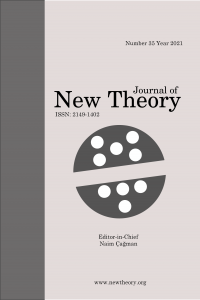Abstract
References
- D. Bertsimas, Performance Analysis of Queueing Networks via Robust Optimization, Operations Research 59(2) (2011) 455–466.
- K. Jiseung, A. Dudin, S. Dudin, K. Chesoong, Analysis of a Semi-Open Queueing Network with Markovian Arrival Process, Performance Evaluation 120 (2018) 1–19. https://doi.org/10.1016/j.peva.2017.12.005
- K. Wu, L. McGinnis, Performance Evaluation for General Queueing Networks in Manufacturing System: Characterizing the Trade-off between que and Utilization, European Journal of Operational Research 221(2) (2012) 328–339.
- O. Dudina, C. Kim, A. Dudin, S. Dudin, Retrial Queuing System with Markovian Arrival Flow and Phase-Type Service Time Distribution, Computers & Industrial Engineering 66(2) (2013) 360–373.
- G. C. Hunt, Sequential Arrays of Waiting Lines, Operations Research 4(6) (1956) 674–683.
- S. Kolledath, K. Kumar, Performance Analysis of Series Queue with Customer’s Blocking, Performance Prediction and Analytics of Fuzzy, Reliability and Queuing Models (2020) 191–201.
- G. Basharin, V. Naumov, K. Samouylov, On Markovian Modelling of Arrival Processes, Stat Papers 59 (2018) 1533–1540. https://doi.org/10.1007/s00362-018-1042-9
- I. F. Akyıldız, H. V. Brand, Exact Solutions for Networks of Queues with Blocking-After-Service, Theoretical Computer Science 125(1) (1994) 111–130.
- M. Zobu, V. Sağlam, M. Sağır, E. Yücesoy, T. Zaman, The Simulation and Minimization of Loss Probability in the Tandem Queueing with Two Heterogeneous Channels, Mathematical Problems in Engineering Article ID 529010 (2013) 4 pages. http://dx.doi.org/10.1155/2013/529010
- V. Sağlam, M. Zobu, A Two-Stage Model Queueing with No Waiting Line between Channels, Mathematical Problems in Engineering Article ID 679369 (2013) 5 pages. http://dx.doi.org/10.1155/2013/679369
Abstract
In this paper, a new blocked tandem queueing model is given and analysed. The arrival process to this queueing model is Poisson with parameter λ. There is one service unit at the first stage of the system, and the service time of this unit is exponentially distributed with $μ_1$ parameter. There are two parallel service units at the second stage, and the service time of these service units are exponentially distributed with parameters $μ_2$ and $μ_3$. No queue is allowed at the first stage of the system. Upon completing service at the first stage, a customer proceeds to the second stage if at least one of the service units at the second stage is available. If both service units at the second stage are busy, the customer blocks the service unit at the first stage, which results in loss. The most important measure of performance of this queueing system is the loss probability $π_{loss}$. First of all, the state probabilities of the system are obtained and then using these probabilities, the steady-state distribution of the system is obtained. Transition probabilities of the system are calculated by using steady-state probabilities, and finally an equation is obtained for $π_{loss}$ in terms of transition probabilities. Furthermore, another measure of performance, the mean number of customers, is obtained in terms of transition probabilities. Since the Equation for $π_{loss}$ is very complex, a numerical method is used to calculate the minimum $π_{loss}$ probabilities. After numerical optimal $π_{loss}$ calculations, a simulation of the queueing system is done, and it is seen that the obtained numerical $π_{loss}$ values tend to simulation results.
References
- D. Bertsimas, Performance Analysis of Queueing Networks via Robust Optimization, Operations Research 59(2) (2011) 455–466.
- K. Jiseung, A. Dudin, S. Dudin, K. Chesoong, Analysis of a Semi-Open Queueing Network with Markovian Arrival Process, Performance Evaluation 120 (2018) 1–19. https://doi.org/10.1016/j.peva.2017.12.005
- K. Wu, L. McGinnis, Performance Evaluation for General Queueing Networks in Manufacturing System: Characterizing the Trade-off between que and Utilization, European Journal of Operational Research 221(2) (2012) 328–339.
- O. Dudina, C. Kim, A. Dudin, S. Dudin, Retrial Queuing System with Markovian Arrival Flow and Phase-Type Service Time Distribution, Computers & Industrial Engineering 66(2) (2013) 360–373.
- G. C. Hunt, Sequential Arrays of Waiting Lines, Operations Research 4(6) (1956) 674–683.
- S. Kolledath, K. Kumar, Performance Analysis of Series Queue with Customer’s Blocking, Performance Prediction and Analytics of Fuzzy, Reliability and Queuing Models (2020) 191–201.
- G. Basharin, V. Naumov, K. Samouylov, On Markovian Modelling of Arrival Processes, Stat Papers 59 (2018) 1533–1540. https://doi.org/10.1007/s00362-018-1042-9
- I. F. Akyıldız, H. V. Brand, Exact Solutions for Networks of Queues with Blocking-After-Service, Theoretical Computer Science 125(1) (1994) 111–130.
- M. Zobu, V. Sağlam, M. Sağır, E. Yücesoy, T. Zaman, The Simulation and Minimization of Loss Probability in the Tandem Queueing with Two Heterogeneous Channels, Mathematical Problems in Engineering Article ID 529010 (2013) 4 pages. http://dx.doi.org/10.1155/2013/529010
- V. Sağlam, M. Zobu, A Two-Stage Model Queueing with No Waiting Line between Channels, Mathematical Problems in Engineering Article ID 679369 (2013) 5 pages. http://dx.doi.org/10.1155/2013/679369
Details
| Primary Language | English |
|---|---|
| Subjects | Mathematical Sciences, Applied Mathematics |
| Journal Section | Research Article |
| Authors | |
| Publication Date | June 30, 2021 |
| Submission Date | May 17, 2021 |
| Published in Issue | Year 2021 Issue: 35 |


